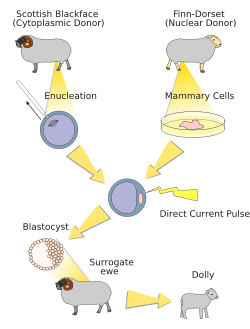Dolly (sheep)

|
WikiDoc Resources for Dolly (sheep) |
|
Articles |
|---|
|
Most recent articles on Dolly (sheep) Most cited articles on Dolly (sheep) |
|
Media |
|
Powerpoint slides on Dolly (sheep) |
|
Evidence Based Medicine |
|
Clinical Trials |
|
Ongoing Trials on Dolly (sheep) at Clinical Trials.gov Trial results on Dolly (sheep) Clinical Trials on Dolly (sheep) at Google
|
|
Guidelines / Policies / Govt |
|
US National Guidelines Clearinghouse on Dolly (sheep) NICE Guidance on Dolly (sheep)
|
|
Books |
|
News |
|
Commentary |
|
Definitions |
|
Patient Resources / Community |
|
Patient resources on Dolly (sheep) Discussion groups on Dolly (sheep) Patient Handouts on Dolly (sheep) Directions to Hospitals Treating Dolly (sheep) Risk calculators and risk factors for Dolly (sheep)
|
|
Healthcare Provider Resources |
|
Causes & Risk Factors for Dolly (sheep) |
|
Continuing Medical Education (CME) |
|
International |
|
|
|
Business |
|
Experimental / Informatics |
Overview
Dolly (July 5, 1996 – February 14, 2003), a ewe, was the first mammal to be successfully cloned from an adult somatic cell. She was cloned at the Roslin Institute in Edinburgh, Scotland, and lived there until her death at age six.[1] Her birth was announced in February 1997.
Premature aging
In 1999 research was published in the journal Nature suggesting that Dolly may have been susceptible to premature aging, due to shortened telomeres in her cells.[2] It was speculated that these were passed on from her donor sibling, who was six years old when the genetic material was taken from her, so that Dolly may have been genetically six years old at birth. This is because telomere length is reduced after each cell division, which requires DNA replication before mitosis occurs. The polymerase, part of the replication machinery, cannot reach the end of the chromosome being replicated and clips a little of the telomere at the end off every time replication occurs.
Possible signs of her condition were reported in January 2002, when Dolly was five years old. She had developed a potentially debilitating form of arthritis at an unusually early age. This supported the theory of premature senescence, although Dr. Dai Grove-White of the Faculty of Veterinary Science at Liverpool University was reported as saying, "Conceivably arthritis could be due to the cloning but equally it could not be. For all we know, she may have damaged her leg jumping over a gate and developed arthritis."
Others speculate that Dolly's arthritis resulted from her lifestyle as a scientific curiosity and protected specimen due to a lack of normal outdoor exercise and unnatural stress on her joints.
Death
On February 15, 2003, it was announced that Dolly had been euthanised because of a progressive lung disease and crippling arthritis. A Finn Dorset such as Dolly would have had a life expectancy of about 12 years, but Dolly only lived to 6 years of age. A necropsy confirmed she had Ovine Pulmonary Adenocarcinoma (Jaagsiekte), a fairly common disease of sheep caused by the retrovirus JSRV. Roslin scientists stated that they did not think there was a connection with Dolly being a clone, and that other sheep on the farm had similar ailments. Such lung diseases are especially a danger for sheep kept indoors, as Dolly had to be for security reasons.
Legacy
After the cloning was successfully demonstrated by Dolly's creators, many other large mammals have been cloned, including horses and bulls.[3] Cloning is now considered a promising tool for preserving endangered species.[4]
Most animal conservation professionals point out that cloning does not alleviate the problems of loss of genetic diversity (see inbreeding) and habitat, and so must be considered an experimental technology for the time being, and all in all would only rarely be worth the cost, which on a per-individual basis far exceeds conventional techniques such as captive breeding or embryo transfer. The attempt to clone argali sheep did not produce viable embryos. The attempt to clone a banteng bull was more successful, as were the attempts to clone mouflon, both resulting in viable offspring. The banteng example is a case illustrating the circumstances under which the uncertainties of cloning attempts are outweighed by the benefits. The cloned dog Snuppy was unfortunately associated with the Korean stem cell scandal involving Hwang Woo-Suk.
References
- ↑ "First cloned sheep Dolly dies at 6", CNN.com, 14 February 2003.
- ↑ Shiels, P.G.; et al. (1999). "Analysis of telomere lengths in cloned sheep". Nature. 399 (6734): 316–317. PMID 10360570 doi:10.1038/20580. BBC article
- ↑ Lozano, Juan A. (June 27, 2005). "A&M Cloning project raises questions still". Bryan-College Station Eagle. Retrieved 2007-04-30.
- ↑ "Texas A&M scientists clone world's first deer" (HTML). Innovations Report. 2003-12-23. Retrieved 2007-01-01.